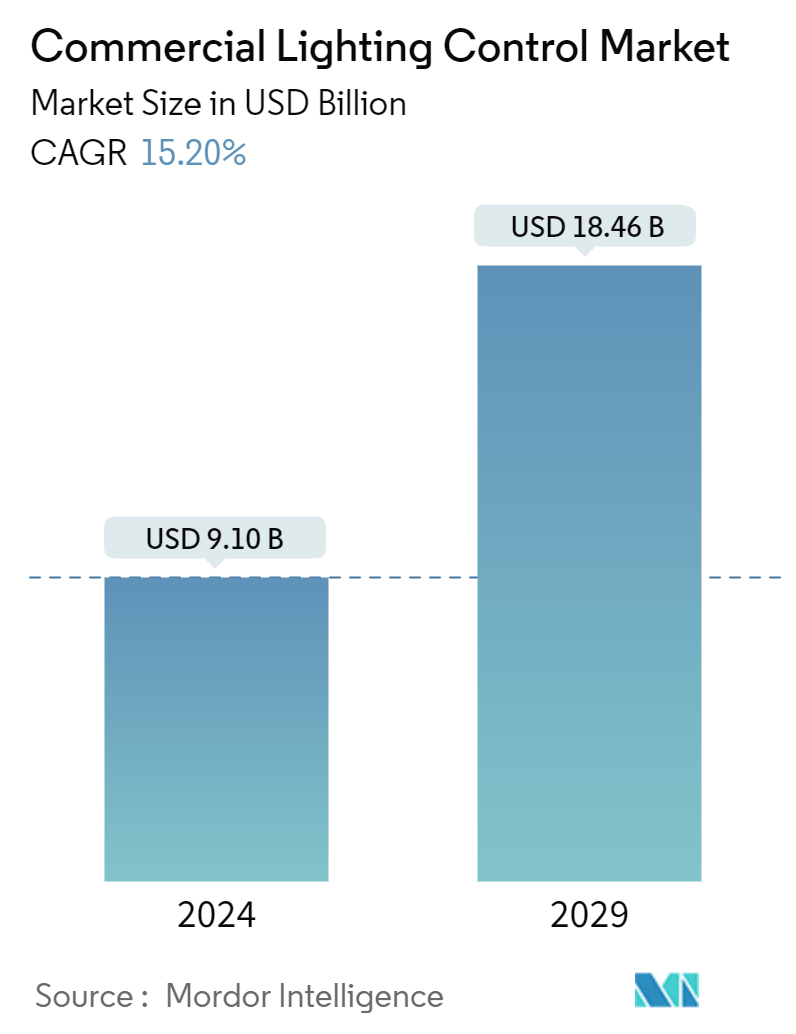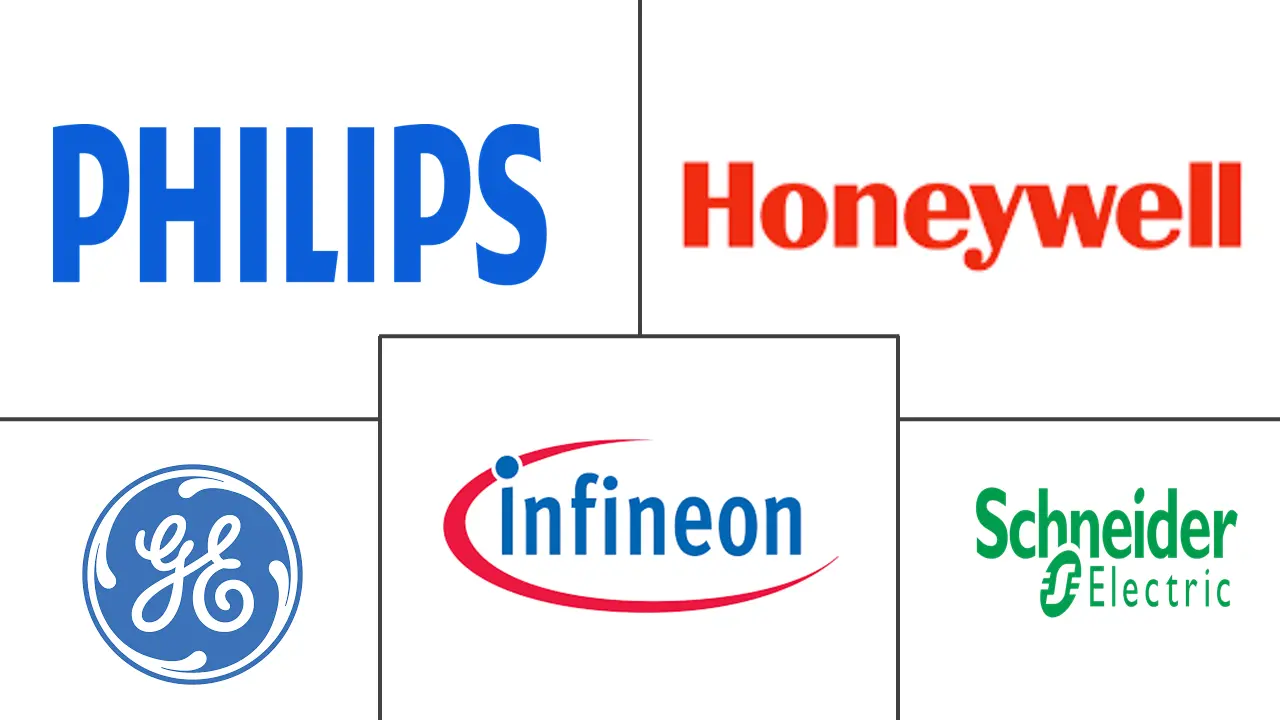Market Size of Commercial Lighting Control Industry

| Study Period | 2022 - 2029 |
| Market Size (2024) | USD 9.10 Billion |
| Market Size (2029) | USD 18.46 Billion |
| CAGR (2024 - 2029) | 15.20 % |
| Fastest Growing Market | Asia Pacific |
| Largest Market | North America |
| Market Concentration | Low |
Major Players
*Disclaimer: Major Players sorted in no particular order |
Commercial Lighting Control Market Analysis
The Commercial Lighting Control Market size is estimated at USD 9.10 billion in 2024, and is expected to reach USD 18.46 billion by 2029, growing at a CAGR of 15.20% during the forecast period (2024-2029).
• The growing economic growth of the developed countries, expansion of commercial buildings, rising awareness toward efficient lighting solutions, various government initiatives to promote LED adoption, etc., are the key factors driving the growth of the studied market. Many governments globally are rapidly phasing out inefficient light sources through performance standards, labeling, and incentive programs, including in Europe, where the transition to LEDs began over a decade ago. The European Union recently updated its regulations under the Ecodesign Directive and the Restriction of Hazardous Substances Directive to phase out virtually all fluorescent lighting in 2023.
• Rising commercial construction activities worldwide will create lucrative growth opportunities for the market. According to the National Bureau of Statistics of China, in 2023, the construction sector made up approximately 6.8% of China's GDP. Real estate and infrastructure construction are vital to the country's economy. During economic downturns, policymakers often invest in infrastructure to stimulate economic growth.
• Development projects involving smart infrastructures, such as new airport terminals, underground roads, and elevated railways, are rising in the countries. This is expected to spur the demand for the commercial lighting control market. However, the high cost of purchasing and installing smart solutions is hindering the market's growth.
• Macroeconomic factors, such as supply chain disruptions, such as natural disasters, and geopolitical tensions, can impact the availability of components, raw materials, and finished products, leading to delays in the production and delivery of LED drivers, sensors, Switches and Dimmers, Relay Units, and Gateways, thus hindering the market growth. Moreover, inadequate infrastructure development in rural and urban areas can hamper the adoption of lighting control, limiting market growth opportunities.
Commercial Lighting Control Industry Segmentation
For market estimation, we have tracked the revenue generated from the sale of types of hardware and software offered by different market players for a diverse range of commercial applications. The market trends are evaluated by analyzing the investments made in product innovation, diversification, and expansion. Further, the advancements in wired and wireless communication protocols are also crucial in determining the growth of the studied market.
The commercial lighting control market is segmented by type (Hardware [LED Driver, Sensors and Switches and Dimmers, Relay Units, Gateways], Software), communication protocol (Wired, Wireless), and geography (North America, Europe, Asia-Pacific, Middle East & Africa, and Latin America). The market sizes and forecasts are provided in terms of value (USD) for all the above segments.
| By Type | |||||||
| |||||||
| Software |
| By Communication Protocol | |
| Wired | |
| Wireless |
| By Geography*** | |
| North America | |
| Europe | |
| Asia | |
| Australia and New Zealand | |
| Middle East and Africa | |
| Latin America |
Commercial Lighting Control Market Size Summary
The commercial lighting control market is poised for significant expansion, driven by factors such as economic growth in developed countries, the proliferation of commercial buildings, and increased awareness of energy-efficient lighting solutions. Government initiatives worldwide are actively promoting the adoption of LED technology, with regulations in regions like Europe phasing out inefficient lighting sources. The market is further bolstered by the rise in commercial construction activities, particularly in countries like China and India, where infrastructure development is a key economic driver. However, challenges such as the high cost of smart lighting solutions and macroeconomic factors like supply chain disruptions and inadequate infrastructure in certain areas may impede market growth.
The demand for advanced lighting control systems is on the rise, fueled by the need for energy efficiency and sustainability. Connected lighting technologies offer significant savings by automating lighting based on occupancy and movement, while also supporting data-driven services. The market is characterized by intense competition, with major players like Philips Lighting NV, Honeywell International Inc., and General Electric Company vying for market share through strategic partnerships, product innovations, and acquisitions. The introduction of new products and technologies, such as motion-sensing systems and integrated linear LED drivers, underscores the industry's commitment to enhancing energy efficiency and meeting the evolving needs of commercial spaces.
Commercial Lighting Control Market Size - Table of Contents
-
1. MARKET INSIGHTS
-
1.1 Market Overview
-
1.2 Industry Attractiveness - Porter's Five Forces Analysis
-
1.2.1 Threat of New Entrants
-
1.2.2 Bargaining Power of Buyers/Consumers
-
1.2.3 Bargaining Power of Suppliers
-
1.2.4 Threat of Substitute Products
-
1.2.5 Intensity of Competitive Rivalry
-
-
1.3 Technology Snapshot
-
1.4 Impact of COVID-19 Aftereffects and Other Macroeconomic Factors on the Market
-
-
2. MARKET SEGMENTATION
-
2.1 By Type
-
2.1.1 Hardware
-
2.1.1.1 LED Drivers
-
2.1.1.2 Sensors
-
2.1.1.3 Switches and Dimmers
-
2.1.1.4 Relay Units
-
2.1.1.5 Gateways
-
-
2.1.2 Software
-
-
2.2 By Communication Protocol
-
2.2.1 Wired
-
2.2.2 Wireless
-
-
2.3 By Geography***
-
2.3.1 North America
-
2.3.2 Europe
-
2.3.3 Asia
-
2.3.4 Australia and New Zealand
-
2.3.5 Middle East and Africa
-
2.3.6 Latin America
-
-
Commercial Lighting Control Market Size FAQs
How big is the Commercial Lighting Control Market?
The Commercial Lighting Control Market size is expected to reach USD 9.10 billion in 2024 and grow at a CAGR of 15.20% to reach USD 18.46 billion by 2029.
What is the current Commercial Lighting Control Market size?
In 2024, the Commercial Lighting Control Market size is expected to reach USD 9.10 billion.

